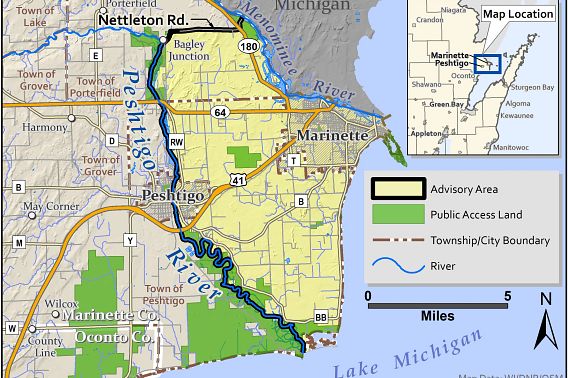Safely Eating Wild Game
Wisconsin has a rich hunting tradition, and wild game is a sustainable, lean source of healthy protein. Whether in the woods and fields or on the water, outdoor adventure and hopefully a tasty, hard-earned meal await hunters in our state. Still, some precautions should be considered before consuming wild game.
Advisories on lead ammunition and consumption from areas where wild animals have known exposure to contaminates in place to keep hunters and their families safe from possible exposure to harmful substances. This page provides information to keep in mind before planning your next hunt.
Consumption Advisory For Deer Liver Harvested In Marinette Area

Per- and poly-fluoroalkyl substances (PFAS) are artificial chemicals in industrial processes and manufactured products. PFAS don't break down easily and can remain for a long time in the environment where people can be exposed to them.
Due to local interest, the Wisconsin Department of Natural Resources studied PFAS levels in deer at the JCI/Tyco Fire Technology Center, 2700 Industrial Parkway, in Marinette. Twenty deer were harvested and measured for PFAS levels in muscle (venison), heart and liver tissues.
For those who eat venison from deer harvested within the five-mile advisory area, the muscle (venison) and heart of white-tailed deer are not likely to result in significant PFAS exposure, according to our findings. Therefore, a PFAS-based consumption advisory is not warranted for the muscles or hearts of deer from this location.
However, our findings suggest that eating liver from deer in this area will likely result in significant PFAS exposure. The liver filters chemicals from the blood, and some substances, like PFAS, can accumulate in the liver over time.
The Wisconsin Department of Health Services and the DNR recommend people do not eat liver harvested from deer within the advisory area.
PFAS can accumulate in our bodies slowly over time through repeat exposure. High levels of PFAS in the body harm human health, especially pregnant women's health. High levels of PFAS in the body may:
- Increase cholesterol levels;
- Decrease how well the body responds to vaccines;
- Increase the risk of thyroid disease;
- Decrease fertility in women;
- Increase the risk of high blood pressure or pre-eclampsia in pregnant women; and
- Lower infant birth weights.
Additional Documents
- Marinette Area Deer Liver Consumption Advisory
- Aviso de consumo de hígado de venado en el área de Marinette
- Yam yuav tsum tau paub txog PFAS uas muaj nyob hauv mos lwj daim siab nyob rau thaj tsam Marinette thiab Peshtigo
- 2020 Deer Liver PFAS Results Summary Report
Lead Ammunition And Wild Game
Deer harvested with lead bullets have been shown to have tiny lead particles or fragments remaining in the processed meat. These are often too small to be seen and can disperse far from the wound channel. Although lead in venison does not rival lead paint in older homes as a health risk for the public, the risk is not low enough to ignore. Children under six years and pregnant women are at the most significant threat from lead exposure. The amount of lead found in a small percentage of venison samples suggests that long-term effects of lead consumption could occur in people who regularly eat venison shot with lead ammunition. However, there is currently no known evidence linking human consumption of venison to lead poisoning.
These suggestions can reduce exposure to lead:
- Consider alternative expanding non-lead ammunition such as copper or other high-weight-retention bullets, such as bonded bullets.
- Practice marksmanship and hunting skills to get closer, making cleaner, lethal shots away from significant muscle areas. Aim for the neck, head, or the vitals behind the shoulder. Don't shoot at running deer.
- Avoid consuming internal organs, which can contain extra lead from heart-lung shots.
- Remind your meat processor, or if you process your venison, not to use deer with excessive shot damage. Always trim a great distance away from the wound channel and discard any meat that is bruised, discolored or contains hair, dirt, bone fragments or grass.
Additional Documents
- Lead Information for Hunters, Consumers and Meat Processors
- Lead exposure in Wisconsin birds
- Lead information for hunters
- Statement on lead ammunition and tackle
- Bullet Fragmentation Study: Supplementary Data
This is an important issue that will continue to be investigated. For a more comprehensive review of lead poisoning, go to the Wisconsin Department of Health Services.
